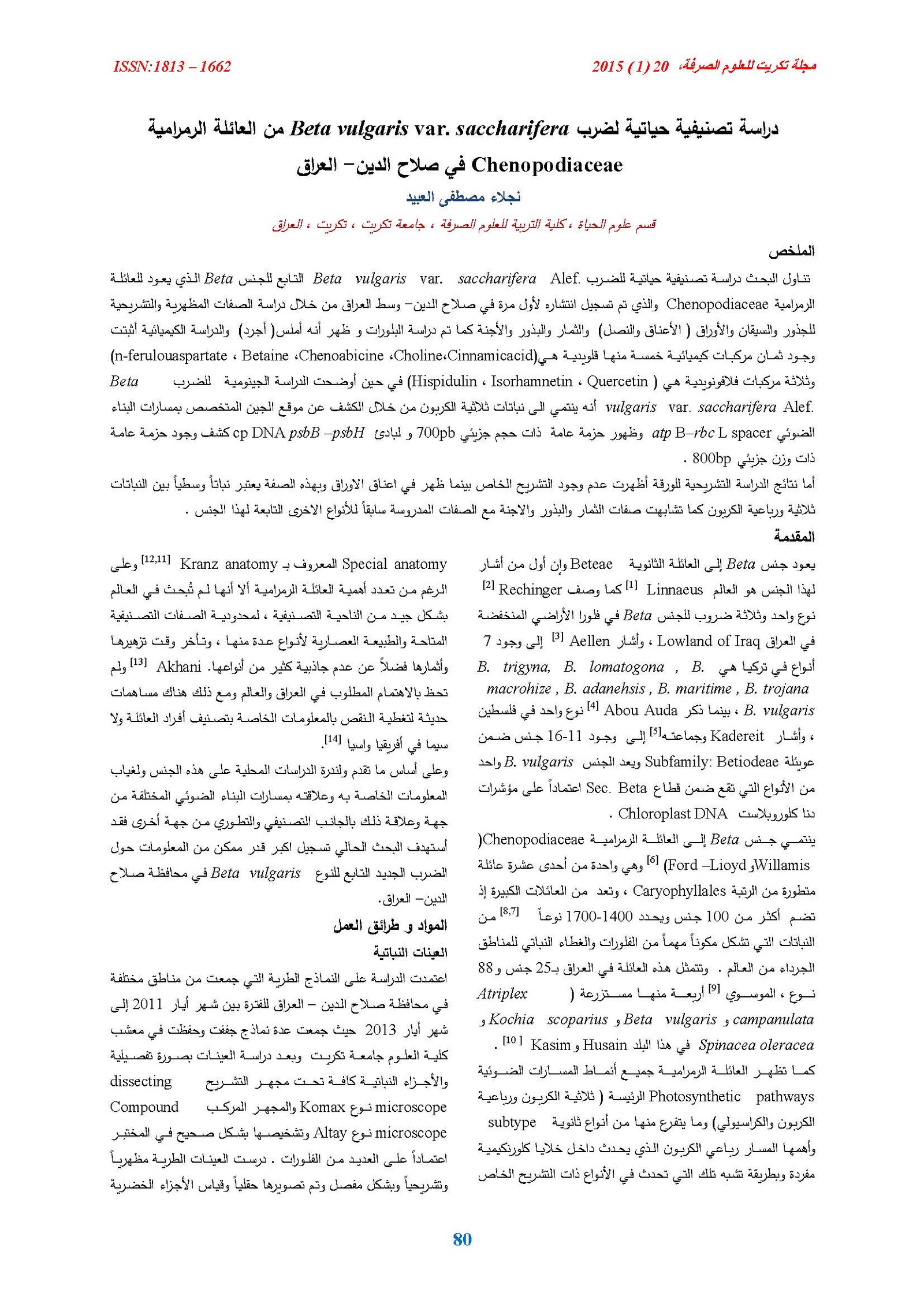Biosystematic study Varity Beta vulgaris var. saccharifera from Chenopodiaceae of Salah Alden mid Iraq.
Main Article Content
Abstract
The present reseach has dealt with Biosystematic Beta vulgaris var. saccharifera Alef. of the genus Beta from the family Chenopodiaceae which has been recorded and distributed the first time in Salahuddin province-mid Iraq.
The distinctive Morphological and anatomical study of roots, stem, leaves (petiole, blads) fruits, seeds and embryos and crystals.
The chemical study provided presence eight compounds (Five alkaloids as Cinnamic acid, Choline, Chenoabicine, Betaine, n-ferulouaspartate and three flavonoids as Quercetin , Isorhamnetin , Hispidulin ).
The study showed that genomic Beta vulgaris var. saccharifera. belongs to the C3 plants by revealing the location of the gene specialist pathways of photosynthesis atp B-rbc L present main bunds Molecular weight 700pb and primary cp DNA psb B-psb H present main bunds Molecular weight 800pb.
The results of the anatomical study of the Leaf showed the absence Kranz anatomy while in the petiole the characters on medial plant betweenC3 and C4 plants were similar characters as fruits, seeds and embryos with already studied characters of other species which belong to this genus.
Article Details

This work is licensed under a Creative Commons Attribution 4.0 International License.
Tikrit Journal of Pure Science is licensed under the Creative Commons Attribution 4.0 International License, which allows users to copy, create extracts, abstracts, and new works from the article, alter and revise the article, and make commercial use of the article (including reuse and/or resale of the article by commercial entities), provided the user gives appropriate credit (with a link to the formal publication through the relevant DOI), provides a link to the license, indicates if changes were made, and the licensor is not represented as endorsing the use made of the work. The authors hold the copyright for their published work on the Tikrit J. Pure Sci. website, while Tikrit J. Pure Sci. is responsible for appreciate citation of their work, which is released under CC-BY-4.0, enabling the unrestricted use, distribution, and reproduction of an article in any medium, provided that the original work is properly cited.
References
1- Linnaeus, C. (1753).Species plantarum , London. p. 218- 222.
2- Rechinger, K.H. (1964). Flora of Lowland Iraq. Verlarg von. J. Cramer, Wein.p.184-186.
3- Aellen, P. (1967). (Chenopodiaceae) in Davis, P. H. Flora of Turkey and the East Aegean Islands. Edinb. Univ. Press.2:315.
4- Abou Auda, M.M, N.Y. Deeb, and K. F. ELSahhar, (2009). The Flora and Plant life forms of wadi Gaza Area ,middle overnorate, Palestine,4thCon.on Recent Technological in Agriculture .201-213pp.
5- Kadereit , G., T. Borsch, K. Weising, and H. Freitage , (2003). Phylogeny of Amaranthaceae and Chenopodiaceae and the evolution of C4 photosynthesis. Int. J. Plant Sci. 164: 959-986.
6- Williams, J. T. and B. V. Ford- Lioyd , (1974). The Systematic of the Chenopodiaceae. Taxon .23:353-354.
7-Jonson, A.D. (1940). Plant Microtechnique.1st ed. McGraw- Hill Book Company, Newyork and London, 523pp.
8- Muhaidat, R., Sage, R.F. and Dengler, N.G. (2007). Diversity of Kranz anatomy and biochemistry in C4Eudicots.
10- Husain, S.M. and M. H. Kasim (1975). Cultivated Plants of Iraq and their Importance. University of Mosul.
11-Voznesenskaya , E.V. , Koteyeva , N.K. and Edwards ,G.E(2010). Conference introduction:2010 symposim on C4 plant biology. China.
12- Zhu , X.(2010). Conference introduction:2010 symposim on C4 plant biology. China.
13-Akhani, H., (2004). Halophytic vegetation of Iran: towards a syn- taxonomical classification. Ann Bot (Rome)4:66-82.
14-Takhtajan, A.L. (1980). Out line of the Classification of flowering plants (Magnoliophyta). Bot. Rev., 46: 225-359.
16- Harborne , J.B. (1973). Phytochemical Methods. A Guide to Modern Techniques of plant Analysis. London, New York, Champman and Hall, P:278.
17- Maniatis ,T., E.F. Fritsch, and J. Sambrook, (2001). In vitro Application of DNA by the Polymerase Chain Reaction, in Molecular Cloning: ALaboratory Manual. 2nd ed., Cold Spring Harbor Laboratory Press, New York, USA,p.691.
18- Zhang, J., ,J.D. Mc stewart (2000)Economical and rapid method for extracting Cotton genomic DNA. Journal of Cotton Sci.4:193-201.
19- Malekloo, H.S., M. Assidi, and M.T. Nejadsatari, (2009). Stem anatomical investigation of the genus Chenopodium L.Jour.on Pl.Sci. seri 14 Num.2. -71.
20- Erdtman, G. (1952). Pollen morphology and plant taxonomy. Angospermas, Aimquist & Wiksell, Stockholm. 539 pp.
21- Rudall, P. (1980). Leaf anatomy of the sub tribe Hyptidinae (Labiatae) Bot. Linn. Soc. J. 80: 319-340.
22- Rudall, P.J. (2007). Anatomy of flowering plants an introduction to structure and development. 3ed ,Cambridge,U.K.,154pp.
25- Freitag, H. and W. Stichler(2002)Bienertia cycloptera Bunge ex Boiss. Chenopodiaceae, another C4 Plant without Kranz tissues. Plant Biol.4,121-132.
27- Akhani, H., P. Trimborn, and H. Ziegler, (1997). Photosynthetic pathways in Chenopodiaceae from Africa , Asia and Europe with their ecological, phytogeographical and taxonomical importance .Pl. Syst. E vol. 206:187-221.
28- Radford , A. E., W. C. Dikson, J. R. Massey , and Bell, C.R. (1974). Vascular Plant Systematics. Harper and Row 891 pp.
29- AL-Jaber, N.A., T.G. Mujahid and H.M.G. AL-Hazimi, (1992) Secondary metabolites of Chenopodiaceae species Jour. Chem. Soc. Pak. 14(1): 77-83.
30- Stume, P.K. and E.E. Cann, (1981). The Biochemistry of plant .Vol. 7.V academic press. New York : p.158.
31- Kamel, M. S., K. M., Mohamod, , K. O., Hassanean, R. Kasai, and K. Yamasaki, (2001). Acylated flavonoid glycosides from Bassia muricata . phytochemistry.57:1259-1262pp.
32- Devos, K.M. and M.D. Gale, (1992) The use of random amplified polymorphic DNA marers in wheat. Theo. and Appl.Genet.84:567-572.
33- Kadereit, G., and H. Freitage, (2011). Molecular Phylogeny of Camphorosmeae (Camphoromoideae ,Chenopodiaceae): Implications for biogeography, evolution of C4 photosynthesis and taxonomy, Taxon 60(1)51-78.
34- Kuhn, U., (1993). Chenopodiaceae. In Kubitzki, K., Rohwer, J.G., Bittrich, V., (Eds): Thr Femilies and genera of vascular plants. 2,pp 253- 281.-Berlin, Heidelberg:Springer.
